Introduction
In the fast-paced world of online shopping, businesses are always looking for creative tactics to stay one step ahead and wow their customers. They’re like modern-day explorers, venturing into the ever-evolving landscape of ecommerce, armed with innovation and a drive to captivate their loyal fans. With a projected 43.4% of total ecommerce sales anticipated to stem from mobile commerce in 2023, the significance of mobile platforms must be considered. However, the ultimate triumph lies in providing personalized experiences throughout the shopper’s journey.
With the increasing adoption of mobile applications, apps are poised to play a significant role in driving sales growth, particularly with Millennials and Gen Zers, who wield considerable purchasing influence. Brands must tailor their app experiences to meet the unique needs of these new-age shoppers, consider their convenience, and identify meaningful ways to engage with these shoppers and foster loyalty.

Get this 63% of smartphone users are more likely to purchase from companies whose mobile sites or apps offer them relevant recommendations on products they may be genuinely interested in.
On top of that, 58% of smartphone users feel more favorable toward companies whose mobile sites or apps remember who they are and their past buying behavior. Let’s uncover the hidden treasures of app personalization and discover the latest tips and tricks to help you stand out in today’s crowded ecommerce landscape.
Step 1: Identify the Right Customers
Do you remember the last time you received an annoying app notification or a message that you completely ignored? While marketers and brands know that irrelevant notifications can leave a bad taste, why do we keep receiving them? The answer lies in the inaccurate app-user segmentation.
App-user segmentation categorizes a mobile application’s user population into smaller groups based on similar characteristics or behaviors. This method helps brands better understand their users and devise customized marketing campaigns and personalized experiences.

Why is it significant? If you segment your users based on their demographics, interests, behavior, or usage habits, you can customize their app’s functionalities and communications to cater to each group’s unique needs and preferences.
How do you segment app users effectively? The following is a six-pronged framework designed to effectively segment app audiences for better results.
- Understand your audience: To understand your app’s users better, consider asking yourself some key questions. Where are your customers coming from? Why do they use your app? Which sections of the app are they interacting with the most, and which ones are they neglecting? When you utilize motivational segmentation models and gather demographic and psychographic data, you gain valuable insights into your audience.
- Use a variety of segmentation criteria: Instead of focusing on a single criterion like gender or location, use multiple measures, such as behavior and interests, and assign engagement levels.
- Define each segment clearly: Each user segment should be well-defined and distinct, apart from some essential characteristics. Don’t overlap. With distinctive segmentation, you can even offer a hyper-personalized experience. Your customers will absolutely adore that.
- Follow the three-adjective rule: Communication expert Frank Luby says, “If you need more than three adjectives, or three dimensions, to define your initial segments, you may be overthinking and over-engineering the effort.” So analyze each user segment thoroughly but don’t overthink it.
- Leverage RFM and cohort analysis: RFM stands for Recency, Frequency, and Monetary value. RFM analysis is a data-driven customer segmentation technique that helps businesses categorize customers based on purchasing behavior.

A typical RFM plot
Cohort analysis involves grouping users based on standard criteria for a specific activity or behavior. Their performance is then observed over some time to look for hidden trends and movements.

Micro analysis of a set of email cohorts on specific days
Monitor, test, and improve: App user segmentation is an ongoing process. It requires a significant amount of testing and optimization. While planning your strategy, consider the fastest-growing group of users. However, avoid using the same segmentation over several years. Instead, revisit and refine your approach by monitoring changes in habits, demographics, motivations, and trends.
To learn more about segmentation on a more granular level, we recommend exploring Netcore’s powerful segmentation engine – Visit Us! Now let’s move on to another crucial aspect of app personalization – utilizing AI and ML to personalize the app experience.
Step 2: Leverage AI and ML
As customers’ demand for personalized experiences continues, you’ll need to create tailored experiences that resonate with your target audience. Fortunately, you can now turn to advanced technologies like Artificial Intelligence (AI) and Machine Learning (ML). Let us discuss a critical use case for brands to leverage the power of these advanced technologies to enhance their app experiences, boost customer satisfaction, and increase loyalty.
Predictive Segments: With modern data analysis tools and recent technological advancements, businesses can better understand and engage with customers’ behavior. However, you’ll need to do more than just understand customer behavior because your customers now continuously expect more.
To meet their rising expectations, you must not only understand your customers’ behavior but also anticipate it. With Predictive Segments, you can forecast future behavior around any activity, predict purchases that will take place on your mobile app, identify shoppers who would engage with cross-sell campaigns, and predict users who are likely to churn or purchase from a particular category on the app automatically. This helps brands send shoppers unique correspondences concerning their predicted action; for example, an app push notification consisting of an offer for an item that shoppers will likely purchase.

Select your action type to bucket a group of people
To learn more about Predictive Segments, visit Netcore, and get proactive on your customer segmentation tactics today.
In conclusion, app personalization involves utilizing advanced technologies like AI and ML to provide customized experiences. One crucial aspect is to provide personalized recommendations and tailored experiences. We will explore these aspects in the next chapter. We will also examine how Netcore’s app personalization functionality incorporates these features to enhance the user experience.
Step 3: Offer tailored in-app experiences at every lifecycle stage
By utilizing AI and machine learning algorithms to analyze user data, you can recommend products, services, or content relevant to the user’s interests and needs. This enhances the user experience and increases the chances of conversion and repeat purchases.
When you understand users’ preferences and behavior patterns, you can offer relevant in-app recommendations and tailored experiences. This improves the overall app experience and tailors marketing strategies to be more effective. All of this impacts the bottom line. The following are a few examples of in-app recommendations across various app screens.
Welcome messages: Make a solid first impression on first-time visitors using pop-up messages, banners, or special promotions. Encourage them to sign up for a newsletter or create an account, which will help to increase engagement on the app.

Cart abandonment triggers: Remind shoppers who have added items to their online shopping cart to complete their purchases. Leverage push notifications and pop-up messages on the app and encourage them to return to the site and complete the transaction.

Product-browse abandonment messages: Send messages to potential shoppers who have viewed a product on the app but have yet to transact. Utilize push notifications designed to remind the shopper of the product they were interested in, and encourage them to convert.
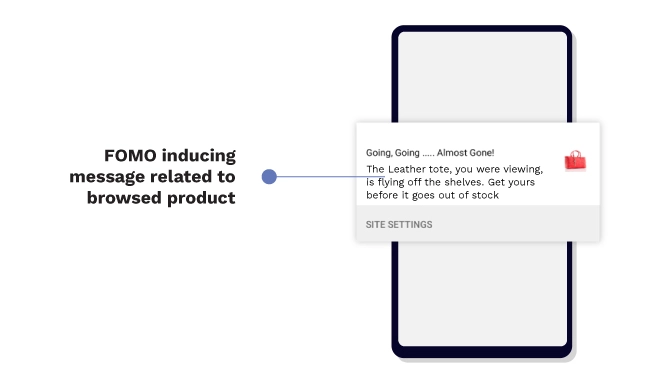
Bestseller recommendations: To highlight the most frequently sold products across your ecommerce store, use widgets that influence a shopper’s purchase decision. Use AI/ML to analyze your site’s overall sales data for a month/fortnight/week/day at a site or category level to recommend top-selling products to your customers.
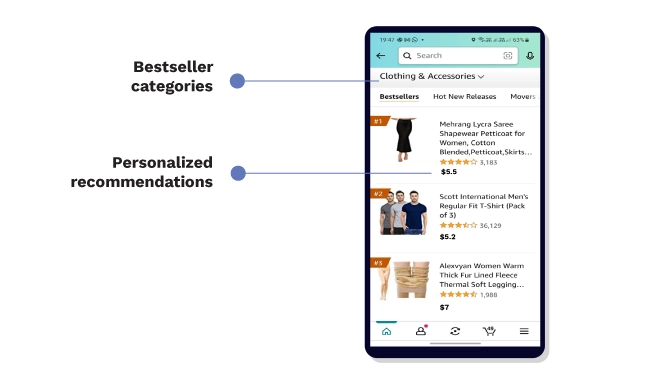
New arrival product recommendations: Prominently display new products that may have just arrived. Give details. Do this as a regular practice with every new product release, a limited-edition launch, or a new collection release.

Recently viewed recommendations: Leverage the power of the data you gathered, such as browsing history, purchase history, and search queries, to understand the preferences and interests of a user, and then suggest items that are likely to be bought across your app.
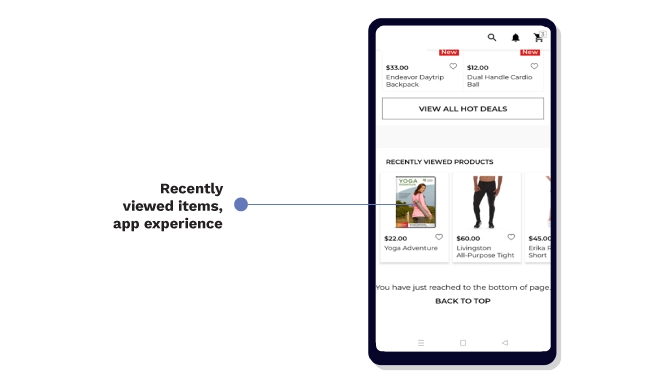
Recommended-for-you suggestions: Showcase items to a user based on their past purchase and browsing. Skillfully tailor these recommendations to the individual user. Give them that special, personalized experience.
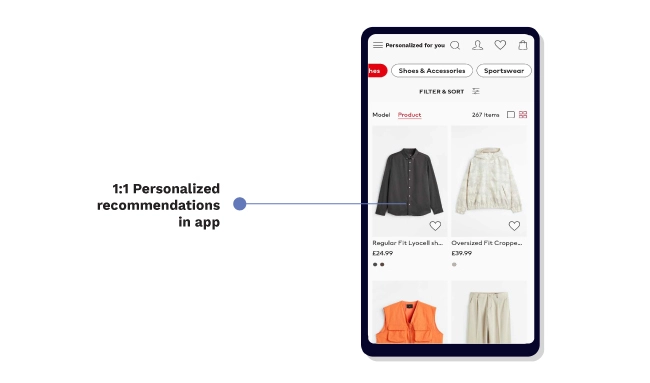
Complete the look: Display products which can be paired with a shopper’s current purchase or browsing tendency. Entice them with a ‘complete-outfit-look.’ Showcase these extra items on the product detail pages or during the checkout process. Increase the chances that the shoppers will purchase these additional items.
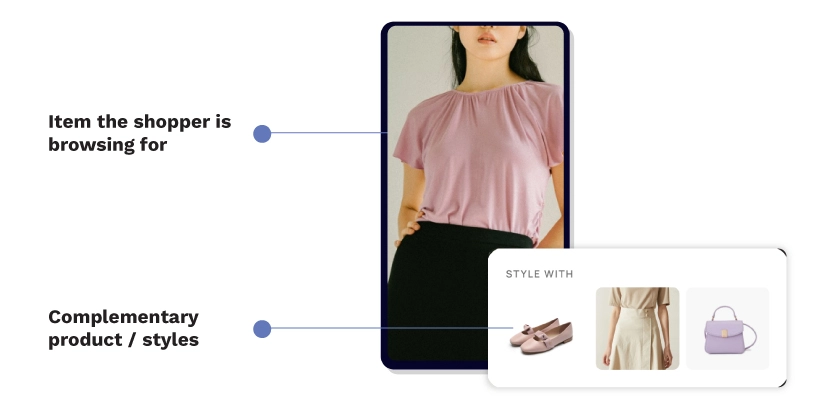
Phew! That was an elaborate demonstration of our app personalization capabilities, from messages to triggers to product recs; we covered it all! But before we proceed to the next chapter, how about reading about these functionalities in detail? Not only across app but also across web, search, email, and more. Download our solutions guide for free and explore our full functionality today.
Step 4: Nudge And Onboard Shoppers With Efficiency
App nudges and walkthroughs are crucial for in-app personalization. They guide users, improve onboarding experiences, and increase engagement. They instruct, highlight key features, and encourage desired actions. They ensure users maximize the app’s potential and have a positive experience. Now, let’s dive in and explore why nudges and walkthroughs are important in-app personalization initiatives:
No code: With nudges and walkthroughs, you no longer need scarce engineering resources to highlight specific sections or features to your particular audience. This significantly reduces the time taken for an app release cycle. Modify app layouts yourself, add or remove elements, and roll out new sections, all at your own discretion.
Smooth onboarding and faster activation: You can now choose from extensive nudge libraries. Use these nudges to contextually navigate users across your product on Day 0 itself to the most critical sections – the sections that tend to attract and retain users.
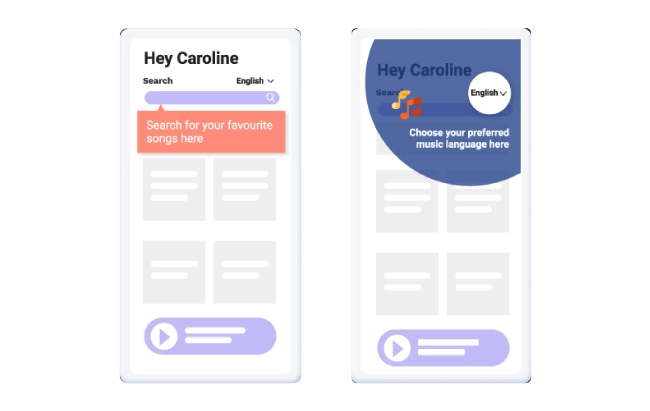
Boost feature-adoption: Showcasing all features on the home screen isn’t really feasible. Instead, use walkthroughs to contextually guide your users to the correct sections based on what stage they are in, in their user lifecycle.
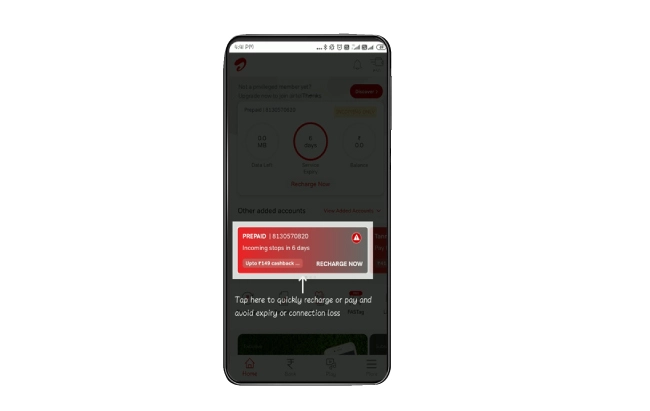
Higher retention via handholding: Contextually nudge and handhold users through the critical cycles, such as canceling a ride or purchase. Help them take decisive action in moments of high intent, such as winning a contest or adding a delivery address.
To learn more about Nudges and Walkthroughs, visit Netcore and explore our comprehensive nudge library. Click on the following link and nudge your way to marketing success in 2023.
Explore Nudges and Walkthroughs Today!
Step 5: Understand the Best Practices For App Personalization in 2023
This chapter will discuss the five best practices for app personalization in 2023. It will provide a roadmap for creating personalized experiences that resonate with users and drive engagement and loyalty. Here are some of the best practices:
- Optimize for different device types: In today’s digital age, people use various devices to access apps, including smartphones, tablets, and smartwatches. Optimize your app for different device types. That way you’ll provide a consistent and seamless experience across all platforms. By doing so, you’ll also cater to your users’ preferences and ensure they remain engaged and satisfied with the app’s performance, regardless of their device.
- Offer customization options: This is a great way to improve app personalization. Allow users to personalize their experience and create a more engaging and personalized app for themselves. This customization can include options such as choosing their preferred interface, color schemes, font sizes, and other settings to improve their overall experience. By doing so, you’ll also cater to your users’ preferences and ensure they remain engaged and satisfied with the app’s performance, regardless of their device.
- Use gamification: Gamification techniques effectively increase user engagement and promote desired behaviors. Leverage these techniques in your app personalization strategies to create a more enjoyable and rewarding user experience. Incorporate badges, points, and leaderboards that motivate users to complete specific actions, such as purchasing or sharing their knowledge with leaderboards that motivate increased loyalty and more retention.
- Leverage user feedback and engagement: One of the most important aspects of app personalization is to gather user feedback and engagement metrics. Analyze these metrics, understand user behavior and preferences, identify pain points, and improve your app’s personalized features and functionality. Monitoring and improving your app’s personalization can increase user satisfaction and loyalty and drive business growth.
- Implement progressive profiling: Progressive profiling is a powerful tool to collect user data in a non-intrusive manner. Ask for only the most critical information upfront so users are more likely to complete the onboarding process. As they continue to use the app, gradually ask for additional details to create a more comprehensive user profile. This approach enhances the user experience and provides your users with more relevant and personalized content and promotions based on their interests and behavior.
With a clear understanding of identifying the right app user segments and leveraging advanced technologies such as AI and ML to offer personalized app experiences, and religiously following the best practices for marketers; it’s time to step into the future of app personalization. Brace yourselves to explore the upcoming trends.
Conclusion
In conclusion, app personalization leaderboards motivate in today’s competitive digital landscape. With the rise of advanced technologies like AI and ML, marketers have more tools than ever to create hyper-personalized experiences.
The future of app personalization is fascinating. Advancements like augmented reality, virtual assistants, and predictive analytics are all set to revolutionize the industry. As customer expectations evolve, brands must stay ahead of the curve and embrace these new technologies to deliver truly personalized experiences.
At Netcore Cloud, we’re dedicated to helping businesses of all sizes leverage the latest advancements in-app personalization. With our comprehensive suite of solutions, including AI-powered recommendations, personalized messaging, and real-time analytics, we can help you deliver the engaging, hyper-personalized experiences your customers crave. To truly scale your marketing efforts, consider leveraging a robust ecommerce marketing platform. Book a demo today to discover how it can transform your business.
To learn more about how Netcore Cloud can help you take your app personalization strategy to the next level.
Also, remember to download our comprehensive solutions guide for marketers, for free, at the link below.











